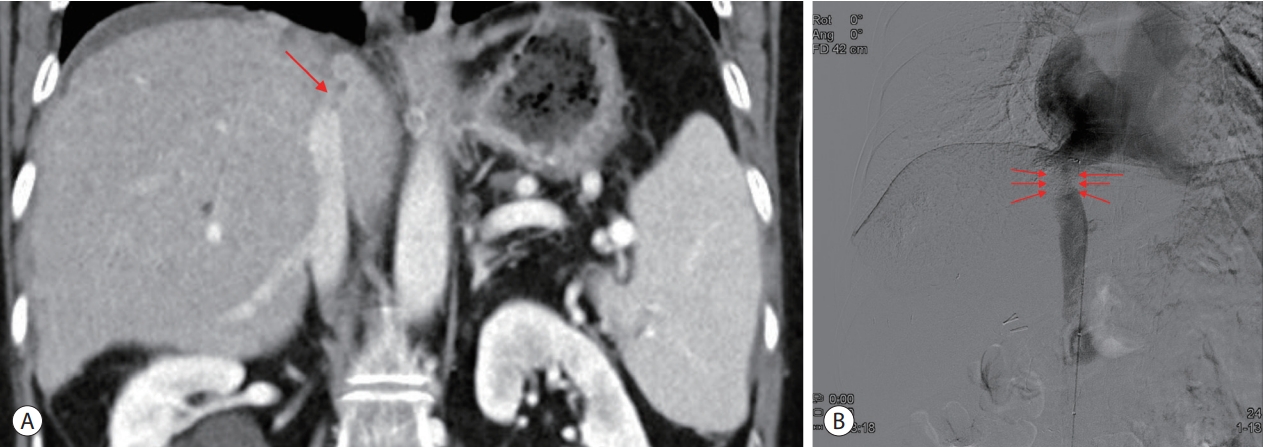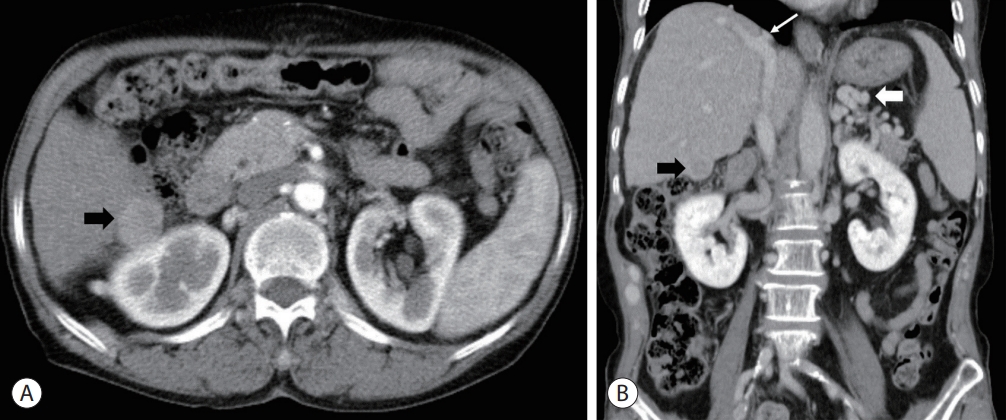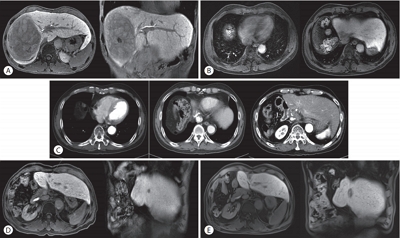Search
- Page Path
- HOME > Search
Case Reports
- Multidisciplinary approach for hepatocellular carcinoma arising from cirrhotic liver with Budd-Chiari syndrome: a case report
- Sangmi Kim, Ji Hoon Kim, Ji Won Han, Jeong Won Jang, Jong Young Choi, Seung Kew Yoon, Pil Soo Sung
- J Liver Cancer. 2022;22(2):202-206. Published online September 20, 2022
- DOI: https://doi.org/10.17998/jlc.2022.09.17

- 1,886 Views
- 45 Downloads
-
 Abstract
Abstract
 PDF
PDF - Budd-Chiari syndrome (BCS) is defined by the obstruction of the hepatic venous outflow between the small hepatic veins and the junction of the inferior vena cava (IVC) with the right atrium. BCS with IVC obstruction occasionally progresses to hepatocellular carcinoma (HCC). Here, we report the case of a patient with HCC arising from a cirrhotic liver with BCS, in whom the hepatic portion of the IVC was obstructed, and who had a favorable outcome with a multidisciplinary approach and IVC balloon angioplasty.

- Hepatocellular carcinoma with Budd-Chiari syndrome due to membranous obstruction of the inferior vena cava with long-term follow-up: a case report
- Choong Hee Kim, Gwang Hyeon Choi, Hee Young Na, Chang Jin Yoon, Jai Young Cho, Sangmi Jang, Ji Hye Kim, Eun Sun Jang, Jin-Wook Kim, Sook-Hyang Jeong
- J Liver Cancer. 2022;22(2):194-201. Published online September 15, 2022
- DOI: https://doi.org/10.17998/jlc.2022.08.24

- 2,334 Views
- 55 Downloads
-
 Abstract
Abstract
 PDF
PDF - Membranous obstruction of the inferior vena cava (MOVC) is a rare subset of Budd-Chiari syndrome (BCS) with a subacute onset that is often complicated by cirrhosis and hepatocellular carcinoma (HCC). Here we report a case of recurrent HCC in a patient with cirrhosis and BCS that was treated with several episodes of transarterial chemoembolization followed by surgical tumorectomy, whereas the MOVC was successfully treated with balloon angioplasty followed by endovascular stenting. The patient was followed up for 9.9 years without anticoagulation and experienced no stent thrombosis. After the tumorectomy, the patient was HCC-free for 4.4 years of follow-up.

- Long-term Disease-free Survival after Trimodality Treatment of Recurrent Hepatocellular Carcinoma Involving the Inferior Vena Cava and Right Atrium
- Sunmin Park, Won Sup Yoon, Hyung Joon Yim, Chai Hong Rim
- J Liver Cancer. 2019;19(2):149-153. Published online September 30, 2019
- DOI: https://doi.org/10.17998/jlc.19.2.149

- 3,576 Views
- 73 Downloads
-
 Abstract
Abstract
 PDF
PDF Supplementary Material
Supplementary Material - Hepatocellular carcinoma (HCC) involving the inferior vena cava (IVC) and/or right atrium (RA) is a rare and intractable disease. A standard treatment has not been established yet, owing to the rarity of disease and difficulties in the therapeutic treatment. Herein, we report the case of a patient who had recurrent HCC (after a prior lobectomy) involving both IVC and RA and underwent multimodality treatments including external beam radiotherapy and transarterial chemotherapy, followed by sorafenib treatment. The disease was well controlled with local treatments and sustained for 7 years until last follow-up after the systemic treatments. Our case shows a possibility of long-term survival for patients affected by HCC involving IVC and/or RA, after a rigorous multimodality treatment strategy.

- A Case of Hepatocellular Carcinoma with Tumor Thrombus in Inferior Vena Cava and Right Atrium
- Hyun Jung Lee, Hyung Joon Yim, Hwan Hoon Chung, Seung Hwa Lee, Hae Rim Kim, Jong Jin Hyun, Sung Woo Jung, Ja Seol Koo, Sang Woo Lee, Jai Hyun Choi
- Journal of the Korean Liver Cancer Study Group. 2012;12(2):141-145. Published online September 30, 2012
- 606 Views
- 2 Downloads
-
 Abstract
Abstract
 PDF
PDF - In patients with advanced hepatocellular carcinoma (HCC), tumor thrombus in inferior vena cava (IVC) and right atrium (RA) are not uncommon findings and are usually associated with extremely poor outcome. Although aggressive surgical interventions such as extracorporeal circulation and tumor excision have been performed, the reported results were still unsatisfactory. Herein, we report the favorable result of combined treatment with radiation therapy and transarterial chemoembolization in a patient with advanced HCC with extensive tumor thrombus through the IVC into the RA. In conclusion, noninvasive combined modalities, such as transarterial chemoembolization and radiation therapy may sometimes provide effective palliation for patients with far advanced HCC with IVC/RA tumor thrombus and who are not candidates for alternative treatment options.

- A Case of Advanced Hepatocellular Carcinoma with Inferior Vena Cava and Right Atrium Invasion Treated with Intra-arterial Chemotherapy
- Kee Myung Lee, Je Han Won, Deok Kee Kim, Jae Geun Kim, Won Seok Kim, Kwang Hyeon Ko, Sung Won Cho
- Journal of the Korean Liver Cancer Study Group. 2001;1(1):107-109. Published online June 30, 2001
- 474 Views
- 2 Downloads
-
 Abstract
Abstract
 PDF
PDF - A 52 year-old-male patient was admitted to our hospital due to hematemesis. Ten years ago, he had been diagnosed chronic hepatitis B and he was heavy alcoholics. He was in the state of SB tube insertion and we had esophagogastroduodenoscopy and found out cardiac varix bleeding and injected history1. On abdominal ultrasonograpy, large hypoechoic mass in left lobe of liver was noted and the mass invaded into hepatic vein, inferior vena cava (IVC), and right atrium. On hepatic arteriography, large hypervascular mass in left lobe of the liver and several small dodules in right lobe were noted. We performed chemoembolization to the nodules in right lobe but cannot performed to the lesion in left love due to arteriovenous shunt. We inserted the chemport catheter to proper hepatic artery and started the intra-arterial chemotherapy (IACT) with 5-FU 250 mg and cisplatin 10 mg for 5 days. After the second cycle of IACT, tumor thrombus in right atrium was disappeared and thrombus in IVC and tumor mass in left lobe were decreased in size. We believed that hepatocellular carcinoma of this patient should be sensitive to chemotherapy and planned the additional IACT treatment.


 E-submission
E-submission THE KOREAN LIVER CANCER ASSOCIATION
THE KOREAN LIVER CANCER ASSOCIATION
 First
First Prev
Prev



 Follow JLC on Twitter
Follow JLC on Twitter